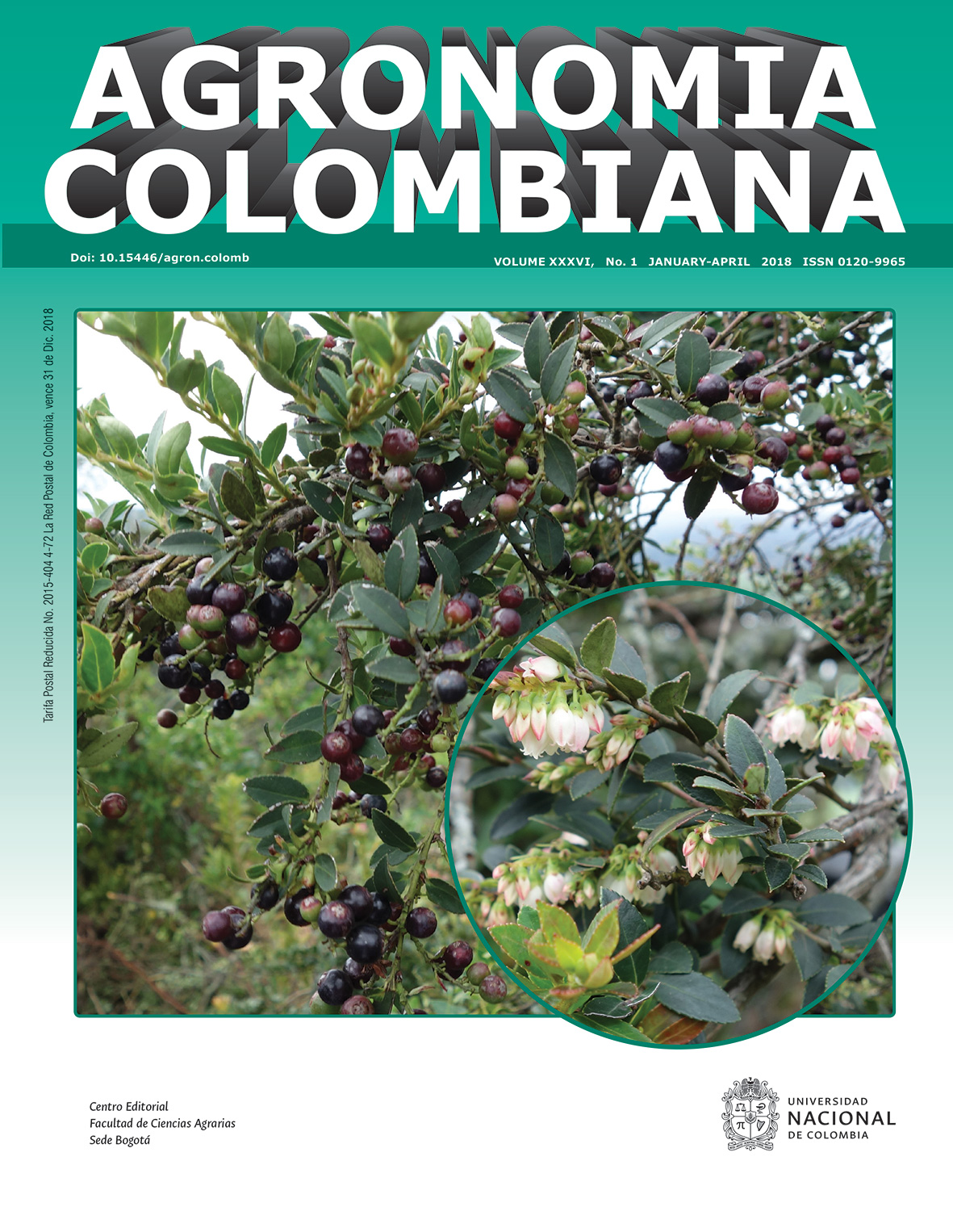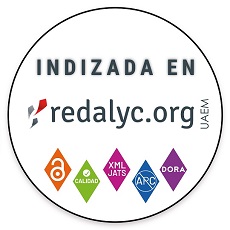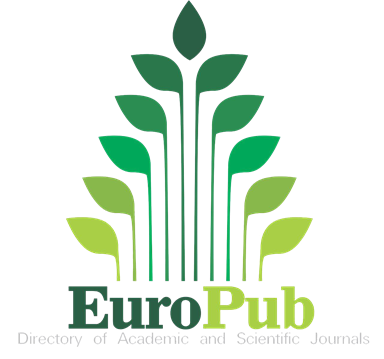Efecto de diferentes fuentes de nitrógeno sobre el crecimiento vegetativo de agraz (Vaccinium meridionale Swartz)
Effect of different sources of nitrogen on the vegetative growth of Andean blueberry (Vaccinium meridionale Swartz)
115/5000 Efeito de diferentes fontes de nitrogênio no crescimento vegetativo de agraz (Vaccinium meridionale Swartz)
DOI:
https://doi.org/10.15446/agron.colomb.v36n1.69304Keywords:
macronutrientes, estacas, índices de crecimiento, Ericaceae. (es)macronutrients, cuttings, growth indexes, Ericaceae. (en)
macronutrientes, estacas, índices de crescimento, Ericaceae (pt)
Downloads
El agraz Vaccinium meridionale Swartz es un arbusto silvestre pequeno, que crece en Colombia en zonas de subparamo, con un alto potencial para posicionarse en el mercado internacional, gracias a su alto contenido de antioxidantes en los frutos. El presente trabajo tuvo como objetivo evaluar el efecto de la fertilizacion con diferentes fuentes de nitrogeno sobre el crecimiento de plantas de agraz en etapa vegetativa, con cuatro tratamientos: testigo sin aplicacion del N, 50% NH4+-50%NO3-, 100% NO3- y 100% NH4+. Se utilizo la dosis de 70 mg L-1 del N en los tratamientos con la aplicacion del nitrogeno. Las plantasM fertilizadas con fuentes amoniacales tuvieron el mejor crecimiento, siendo el tratamiento de 100% NH4+ el que obtuvo el mayor numero de brotes (22), mayor numero de hojas (254) por planta y mayores pesos secos de los organos a los 148 dias despues de la siembra de estacas enraizadas, seguido del tratamiento con 50%NH4 +-50%NO3-. Los tratamientos con 0% N y 100% NO3- tuvieron una mayor sintesis de antocianinas y una menor cantidad de clorofilas en hojas con respecto a las plantas fertilizadas con fuentes de NH4+. Las plantas fertilizadas con 0% N y 100% NO3- presentaron un crecimiento menor que aquellas fertilizadas con 50% NH4+-50%NO3- y 100%NH4+. Este estudio permite afirmar que el agraz requiere planes de fertilización con fuentes amoniacales.
The Andean blueberry (Vaccinium meridionale Swartz) is a small wild shrub that grows in Colombia in sub-paramo areas. The berry has a high export potential due to the high content of antioxidants in the fruits. The objective of the present research was to evaluate the effect of fertilization with different nitrogen sources on the vegetative growth of plants with four treatments: a control of 0% N, 50%NH4 +-50%NO3 -, 100% NO3 -, and 100% NH4+. The dose of 70 mg L-1 N was used in the treatmentsM with application of N. The plants with best growth were those fertilized with ammonia sources. The treatment with 100% NH4+ obtained the highest average number of shoots (22) and leaves (254) per plant, and the highest dry weight of plant
organs at 148 d after planting of rooted cuttings followed by treatment with 50%NH4 +-50%NO3-. Applications of 0% N and 100% NO3- resulted in higher rates of anthocyanin synthesis and lower contents of chlorophyll in leaves regarding to the N sources containing NH4+. The plants fertilized with 0% N and 100% NO3- presented lesser growth than those fertilized with 50%NH4 +-50%NO3 -and 100% NH4+. This study allows to conclude that the Andean blueberry requires a fertilization Mplan with ammonia sources.
References
Abreu, O.A., G. Barreto, and S. Prieto. 2014. Vaccinium (Ericaceae): Ethnobotany and pharmacological potentials. Emirat. J. Food Agric. 26(7), 577-591. Doi: 10.9755/ejfa.v26i7.16404
Alt, D.S., J.W. Doyle, and A. Malladi. 2017. Nitrogen-source preference in blueberry (Vaccinium sp.): Enhanced shoot nitrogen assimilation in response to direct supply of nitrate. J. Plant Physiol. 216, 79-87. Doi: 10.1016/j.jplph.2017.05.014
Birkhold, K.T. and R.L. Darnell. 1993. Contribution of storage and currently assimilated nitrogen to vegetative and reproductive growth of rabbiteye blueberry. J. Amer. Soc. Hort. Sci. 118(1), 101-108.
Bryant, J.P., F.S. Chapin, and D.R. Klein. 1983. Carbon/nutrient balance of boreal plants in relation to vertebrate herbivory. Oikos 40, 357-368.
Bryla, D.R. and B.C. Strik. 2015. Nutrient requirements, leaf tissue standards, and new options for fertigation of northern high-bush blueberry. HortTech. 25(4), 464-470.
Chamorro, F.J. and G. Nates-Parra. 2015. Floral and reproductive biology of Vaccinium meridionale (Ericaceae) in the Eastern Andes of Colombia. Rev. Biol. Trop. 63(4), 1197-1212.
Contreras, J., L. Calderón-Jaimes, E. Guerra-Hernández, and B. García-Villanova. 2011. Antioxidant capacity, phenolic content and vitamin C in pulp, peel and seed from 24 exotic fruits from Colombia. Food Res. Int. 44(7), 2047-2053. Doi: 10.1016/j.foodres.2010.11.003
Curtis, P.S. and A. Láuchli. 1986. The role of leaf area development and photosynthetic capacity in determining growth of kenat under moderate salt stress. Aust. J. plant physiol. 18, 553-565.
Fang, Y., J. Williamson, R. Darnell, Y. Li, and G. Liu. 2017. Nitrogen uptake and allocation at different growth stages of young southern highbush blueberry plants. HortSci. 52(6), 905-909. Doi: 10.21273/HORTSCI11723-17
Ferlemi, A.V. and F.N. Lamari. 2016. Berry leaves: an alternative source of bioactive natural products of nutritional and medicinal value. Antioxidants 5(2), 1-20. Doi: 10.3390/antiox5020017
Flórez, V. and R. Cruz. 2004. Guías de Laboratorio de Fisiología Vegetal. Unibiblos, Universidad Nacional de Colombia, Bogotá.
Glonek, J. and A. Komosa. 2013. Fertigation of highbush blueberry (Vaccinium corymbosum L.). Part I. The effect on growth and yield. Acta Sci. pol., Hortorum Cultus 12(3), 47-57.
Garzón, G.A., C.E. Narváez, K.M. Riedl, and S.J. Schwartz. 2010. Chemical composition, anthocyanins, non-anthocyanin phenolics and antioxidant activity of wild bilberry (Vaccinium meridionale Swartz) from Colombia. Food Chem. 122, 980-986. Doi: 10.1016/j.foodchem.2010.03.01
González, M., I. Samudio, L.G. Sequeda-Castañeda, C. Celis, J. Iglesias, and L. Morales. 2017. Cytotoxic and antioxidant capacity of extracts from Vaccinium meridionale Swartz (Ericaceae) in transformed leukemic cell lines. J. Appl. pharm. Sci. 7(3), 24-30. Doi: 10.7324/JApS.2017.70305
Greidanus, T., L.A. Peterson, L.E. Schrader, and M.N. Dana. 1972. Essentiality of ammonium for cranberry nutrition. J. Amer. Soc. Hort. Sci. 97, 272-277.
Hunt, R. 2013. Basic growth analysis: plant growth analysis for beginners. Unwin Hyman Ltd., London.
IGAC. 2006. Métodos analíticos del laboratorio de suelos. 6th ed. Instituto Geográfico Agustín Codazzi, Bogotá.
Korcak, R.F. 1988. Nutrition of blueberry and other calcifuges. Hort. Rev. 10, 183-227.
Lee, J., R.W. Durst, and R.E. Wrolstad. 2005. Determination of total monomeric anthocyanin pigment content of fruit juices, beverages, natural colorants, and wines by the pH differential method: Collaborative study. J. AOAC Int. 88(5), 1269-1278.
Leitzke, L., L. Picolotto, I. Pereira, G. Vignolo, J. Schmitz, M. Vizzotto, and L. Antunes. 2015. Nitrogen fertilizer affects the chemical composition of the substrate, the foliar nutrient content, the vegetative growth, the production and fruit quality of blueberry. Científica, 43(4), 316-324.
Li, D., B. Li, Y. Ma, X. Sun, Y. Lin, and X. Meng. 2017. Polyphenols, anthocyanins, and flavonoids contents and the antioxidant capacity of various cultivars of highbush and half-high blueberries. J. Food Composit. Anal. 62, 84-93. Doi: 10.1016/j.jfca.2017.03.006
Ligarreto, G.A., M.D.P. Patiño, and S.V. Magnitskiy. 2011. Phenotypic plasticity of Vaccinium meridionale (Ericaceae) in wild populations of mountain forests in Colombia. Rev. Biol. Trop. 59(2), 569-583.
López־Padilla, A., D. Martín, D. Villanueva, L. Jaime, A. Ruiz-Rodríguez, C.E. Restrepo, D.M. Rivero, and T. Fornari. 2017. Vaccinium meridionale Swartz extracts and their addition in beef burgers as antioxidant ingredient. J. Sci. Food Agric. 97, 1097-1110. Doi: 10.1002/jsfa.8483
Maldonado, M.E., S.S. Arango-Varela, and B.A. Rojano. 2014. Free radical scavenging capacity and cytotoxic and antiproliferative effects of Vaccinium meridionale Sw. against colon cancer cell lines. Rev. Cubana plant Med. 19(2), 172-184.
Maqbool, R. 2013. Nitrogen cycling, optimization of plant nutrition and remote sensing of leaf nutrients in wild blueberries (Vaccinium angustifolium Ait.). PhD Thesis, Dalhousie University, Halifax, Canada.
Merhaut, D. and R. Darnell. 1995. Ammonium and nitrate accumulation in containerized southern highbush blueberry plants. HortSci. 30, 1378-1381.
Merhaut, D. and R. Darnell. 1996. Vegetative growth and nitrogen/ carbon partitioning in blueberry as influenced by nitrogen fertilization. HortSci. 121(5), 875-879.
Montoya, C.G., J.D.H. Arredondo, M.L. Arias, C.I.M. Cano, and B.A. Rojano 2012. Cambios en la actividad antioxidante en frutos de mortiño (Vaccinium meridionale Sw.) durante su desarrollo y maduración. Rev. Fac. Nal. Agr. Medellín 65(1), 6487-6495. Doi: 10.15446/rfnam
Percival, D.C. and J.P. Privé. 2002. Nitrogen formulation influences plant nutrition and yield components of lowbush blueberry (Vaccinium angustifolium Ait). Acta Hort. 574, 347-351. Doi: 10.17660/ActaHortic.2002.574.52
Peterson, L.A., E.J. Stang, and M.N. Dana. 1988. Blueberry response to NH4+-N and NO3 --N. J. Amer. Soc. Hort. Sci. 113, 9-12.
Poonnachit, U. and R. Darnell. 2004. Effect of ammonium and nitrate on ferric chelate reductase and nitrate reductase in Vaccinium species. Annals Bot. 93, 399-405. Doi: 10.1093/aob/mch053
Routray, W. and V. Orsat. 2011. Blueberries and their an-thocyanins: factors affecting biosynthesis and properties. Compr. Rev. Food Sci. Food Safety 10(6), 303-320. Doi: 10.1111/j.1541-4337.2011.00164.x
Salisbury, F.B. and C.W. Ross. 2000. Fisiología de las plantas. Desarrollo de las plantas y Fisiología Ambiental. Editorial Paraninfo, Madrid.
Sugiyama, N. and K. Ishigaki. 1994. Uptake of nitrate-nitrogen by blueberry plants. J. plant Nutr. 17(11), 1975-1982. Doi: 10.1080/01904169409364859
Tamada, T. 2004. Effects of nitrogen sources on growth and leaf nutrient concentrations of 'Tifblue'rabbiteye blueberry under water culture. Small Fruits Rev. 3(1-2), 149-158. Doi: 10.1300/J301v03n01_15
Takamizo, T. and N. Sugiyama. 1991. Growth responses to N forms in rabbiteye and highbush blueberries. J. Jpn. Soc. Hort. Sci. 60, 41-45.
Townsend, L.R. 1967. Effect of ammonium nitrogen and nitrate nitrogen, separately and in combination, on the growth of highbush blueberry. Can. J. plant Sci. 47, 555-562.
Townsend, L.R. 1969. Influence of form of nitrogen and pH on growth and nutrient levels in the leaves and roots of the low-bush blueberry. Can. J. plant Sci. 49, 333-338.
Williams, L. and T.E. Martinson. 2003. Nondestructive leaf area estimation of 'Niagara' and 'DeChaunac' grapevines. Sci. Hort. 98, 493-498.
Zapata, I.C., V. Villacorta, M.E. Maldonado, D. Castro-Restrepo, and B. Rojano. 2015. Antioxidant and cytotoxic activity of black and green tea from Vaccinium meridionale Swartz leaves. J. Med. Plants Res. 9(13), 445-453. Doi: 10.5897/JMpR2014.5744
Zapata, I.C., S. Ochoa, M.E. Maldonado, A.D. Zapata, and B.I. Rojano. 2016. Cytotoxic effect and antioxidant activity of Andean berry (Vaccinium meridionale Sw) wine. J. Med. plants Res. 10(27), 402-408. Doi: 10.5897/JMpR2016.6100
Yepes, A. and M.S. Buckeridge. 2011. Respuestas de las plantas ante los factores ambientales del cambio climático global: Revisión. Colombia Forestal 14(2), 213-232. Doi: 10.14483/issn.2256-201X
How to Cite
APA
ACM
ACS
ABNT
Chicago
Harvard
IEEE
MLA
Turabian
Vancouver
Download Citation
CrossRef Cited-by
1. Mariam Vásquez-Martínez, Pedro Lizarazo-Peña, Enrique Darghan, Liz Patricia Moreno-Fonseca, Stanislav Magnitskiy. (2022). Leaf area prediction models from growth measurements in Andean blueberry (Vaccinium meridionale Swartz) in the nursery. Agronomía Colombiana, 40(3), p.361. https://doi.org/10.15446/agron.colomb.v40n3.105039.
2. Oliver G. LEAL-AYALA, Manuel SANDOVAL-VILLA, Libia I. TREJO-TÉLLEZ, Alberto SANDOVAL-RANGEL, Marcelino CABRERA-DE LA FUENTE, Adalberto BENAVIDES-MENDOZA. (2021). Nitrogen form and root division modifies the nutrimental and biomolecules concentration in blueberry (Vaccinium corymbosum L.). Notulae Botanicae Horti Agrobotanici Cluj-Napoca, 49(1), p.11998. https://doi.org/10.15835/nbha49111998.
3. Mitchell Andrews, John A. Raven. (2022). Root or shoot nitrate assimilation in terrestrial vascular plants – does it matter?. Plant and Soil, 476(1-2), p.31. https://doi.org/10.1007/s11104-021-05164-9.
4. Stanislav Magnitskiy. (2023). Native plants from the genus Vaccinium in Colombia and their potential uses. A review. Revista Colombiana de Ciencias Hortícolas, 17(1) https://doi.org/10.17584/rcch.2023v17i1.15503.
5. S.E. Parks, J. Jarvis, D. Unsworth, M. Simpson, D. Sun. (2023). Better management of soilless potting media for southern highbush blueberry, an Australian case study. Acta Horticulturae, (1357), p.79. https://doi.org/10.17660/ActaHortic.2023.1357.12.
6. María Ignacia Arias, Adriana Nario, Krystel Rojas, Poulette Blanc, Claudia Bonomelli. (2024). Newly Established Blueberry Plants: The Role of Inorganic Nitrogen Forms in Nitrogen and Calcium Absorption. Horticulturae, 10(11), p.1168. https://doi.org/10.3390/horticulturae10111168.
Dimensions
PlumX
Article abstract page views
Downloads
License
Copyright (c) 2019 Agronomía Colombiana

This work is licensed under a Creative Commons Attribution-NonCommercial-ShareAlike 4.0 International License.
© Centro Editorial de la Facultad de Ciencias Agrarias, Universidad Nacional de Colombia
Reproduction and quotation of material appearing in the journal is authorized provided the following are explicitly indicated: journal name, author(s) name, year, volume, issue and pages of the source. The ideas and observations recorded by the authors are their own and do not necessarily represent the views and policies of the Universidad Nacional de Colombia. Mention of products or commercial firms in the journal does not constitute a recommendation or endorsement on the part of the Universidad Nacional de Colombia; furthermore, the use of such products should comply with the product label recommendations.
The Creative Commons license used by Agronomia Colombiana journal is: Attribution - NonCommercial - ShareAlike (by-nc-sa)

Agronomia Colombiana by Centro Editorial of Facultad de Ciencias Agrarias, Universidad Nacional de Colombia is licensed under a Creative Commons Reconocimiento-NoComercial-CompartirIgual 4.0 Internacional License.
Creado a partir de la obra en http://revistas.unal.edu.co/index.php/agrocol/.





















